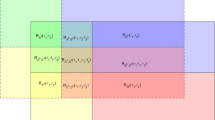Abstract
In this paper, a class of generalized orthogonal sequences (GOS) is presented with the the following characteristics, (1) the cross-correlations in the vicinity of zero shift (zero shift is excluded) between two arbitrary sequences from different GOS sets are zeros; (2) the cross-correlations in the vicinity of zero shift between two arbitrary sequences from different subsets of the same GOS set are zeros; and (3) two arbitrary different sequences from the same subset of the same GOS set are orthogonal. By applying the GOS sets to multi-rate multi-cell quasi-synchronous CDMA (QS-CDMA) system, the system interference is analyzed and compared with that of well-known concatenated orthogonal/PN sequence sets. It is shown that due to the zero correlation properties in the vicinity of zero shift, the interference of system employing GOS sets can achieve a bigger reduction than concatenated orthogonal/PN sequence sets, thus resulting better BER performance than that of latter under the same conditions.
Similar content being viewed by others
References
Pursley, M. B. (1977). Performance evaluation for phase-coded spread-spectrum multiple-access communication-part I: system analysis. IEEE Transactions on Communication, COM-25, 795–799.
Pursley, M. B., & Sarwate, D. V. (1977). Performance evaluation for phase-coded spread-spectrum multiple-access communication-part II: Code sequence analysis. IEEE Transactions on Communication, COM-25, 800–803.
Sarwate, D. V., Pursley, M. B., & Basar, T. U. (1984) Partial correlation effects in direct-sequence spread-spectrum multiple-access communication systems. IEEE Transactions on Communication, COM-32, 567–573.
Hu T. H., Liu M. K. (1998) DS-CDMA System with variable-rate traffic. IEEE Communication Letter 2: 64–66
Tang X. H., Mow W. H. (2006) Design of spreading codes for quasi- synchronous CDMA with intercell interference. IEEE Journal of Select Areas Commmunication 24: 84–93
Fan, P. Z. (2002). New direction in spreading sequence design and the related theoretical bounds, (Invited Talk). In International conference of communications, circuits and systems, PRC
Hao, L., & Fan, P. Z. (2003). Performance evaluation for a new quasi-synchronous CDMA system employing generalized orthogonal sequences. IEICE Transactions on Information and System, E86-D, 1513–1524.
Deng X. M., Fan P. Z. (2000) Spreading sequence sets with zero correlation zone. IEE Electronics Letters 36: 993–994
Fan, P. Z., & Hao, L. (2000). Generalized orthogonal sequences and their applications in synchronous CDMA systems. IEICE Transactions on Fundamentals, E83–A, 1–16.
Salmasi, A., & Gilhousen K. S. (1991). On the system design aspects of code division multiple access (CDMA) applied to digital cellular and personal communications networks. Proceedings of IEEE VTC (pp. 57–62).
Fong, M. H., Wang, Q., & Bhargava, V. K. (1994). Concatenated orthogonal/PN codes for DS-CDMA systems in a multiuser and multipath fading environment. In Proceedings of IEEE Globecom (1642–1646).
Fong M. H., Bhargava V. K., Wang Q. (1996) Concatenated orthogonal/PN spreading sequences and their application to cellular DS-CDMA system with integrated traffic. IEEE Journal of Select Areas Communication 15: 547–558
Proakis J. G. (1983) Digital communication. McGraw-Hill, New York
Author information
Authors and Affiliations
Corresponding author
Rights and permissions
About this article
Cite this article
Feng, L., Fan, P., Tang, X. et al. The Construction of GOS Spreading Code Sets and Their Applications into Multi-Rate Multe-Cell QS-CDMA Systems. Wireless Pers Commun 67, 435–451 (2012). https://doi.org/10.1007/s11277-012-0831-z
Published:
Issue Date:
DOI: https://doi.org/10.1007/s11277-012-0831-z




